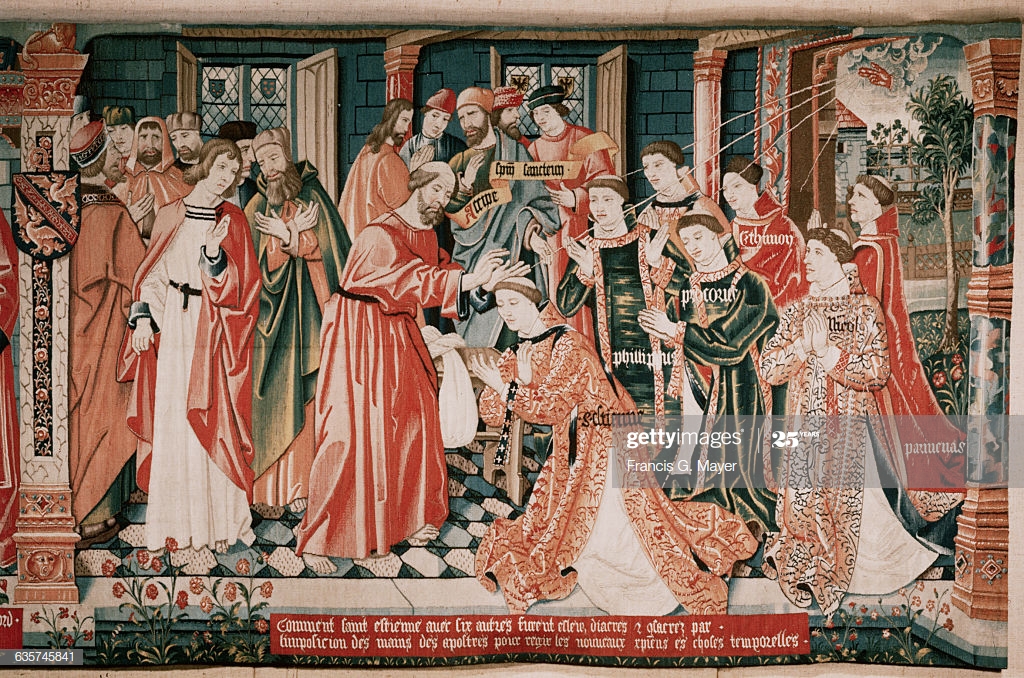This mass will be livestreamed on YouTube at 10 A.M. Sunday May 10, 2020
Here is the program.

The Legend of St. Stephen: The Appointment of the First Deacons (Photo by Francis G. Mayer/Corbis/VCG via Getty Images)
Mount Calvary Church
A Roman Catholic Parish
The Personal Ordinariate of the Chair of St. Peter
Baltimore, Maryland
Rev. Albert Scharbach, Pastor
Dr. Allen Buskirk, Choir Director and Cantor
Midori Tanaka, Organist
May 3, 2020
10 A.M. Livecast on YouTube
Easter V
______________________
Common
Missa de S. Maria Magdalena, H. Willan
___________________
Anthems
Christ rising again, Thomas Tallis (1510-1585)
Christ rising again from the dead now dieth not.
Death from henceforth hath no pow’r upon him.
For in that he died he died but once to put away sin;
but in that he liveth, he liveth unto God.
And so likewise, count yourselves dead unto sin,
but living unto God in Christ Jesus our Lord.
Christ is risen again,
the first fruits of them that sleep.
For seeing that by man came death,
by man also cometh the resurrection of the dead.
For as by Adam all men do die,
so by Christ all men shall be restored to life. Alleluia
Christ rising again is an extended work, divided into two clear parts and based on a text used only at Morning Prayer on Easter Day. Tallis’s setting shows his fluency at five-part imitative writing with some passages of strong rhythmic contrast, such as at the words ‘by man also cometh the resurrection of the dead’. The anthem ends with a rising sequence of Alleluias, underscoring the resurrection theme of the text.
_________
God be in my head, Henry Walford Davies (1869-1941)
God be in my head, and in my understanding;
God be in mine eyes, and in my looking;
God be in my mouth, and in my speaking;
God be in my heart, and in my thinking;
God be at mine end, and at my departing.
The first trace of this very moving verse is in a French text dating from ca. 1490:
Jesus soit en ma teste et mon entendement.
Jesus soit en mes yeulx et mon regardement.
Jesus soit en ma bouche et mon parlement.
Jesus soit en mon coeur et en mon pensement.
Jesus soit en ma vie et mon trépassement. Amen.
The English text is found in a Book of Hours printed by Robert Pynson at London, Hore beate marie/virginis ad vsum in/signis ac prelare ec/clesie Sarum (Salisbury) in 1514. It was then printed in a Sarum Primer of 1558. It must have become well known: it was printed with slight alteration in John Cosin*’s A Collection of Private Devotions in the Practice of the Ancient Church (1627).
It was revived early in the 20th century and was given many tunes, the most lasting being the one by Walford Davies. Davies (1869-1941) was a distinguished church musician and music professor, and was Master of the King’s Music – but at the same time worked at the grass roots, with choirs, community music, broadcasting, hymn book editing, adjudicating at festivals, and the writing of stirring military melodies.
_______________
Hymns
Christ the lord is risen today (VICTIMAE PASCHALI) is a translation by Jane Elizabeth Leeson (1807-1881) of the Easter sequence, Victimae paschali laudes, attributed to St. Wipo of Burgundy (c. 1000). The Council of Trent eliminated scores of sequences in the Roman liturgy. This was one of the four that survived. Leeson first joined the charismatic Catholic Apostolic Church (Irvingites) and later became a Roman Catholic.
Be joyful Mary, heavenly Queen is a translation of Regina coeli, iubila, an anonymous 17th century hymn. The tune was written by Johann Leisentritt (1527-1586), and published in his Catholicum Hymnologium Germanicum in 1584.
Many thanks!